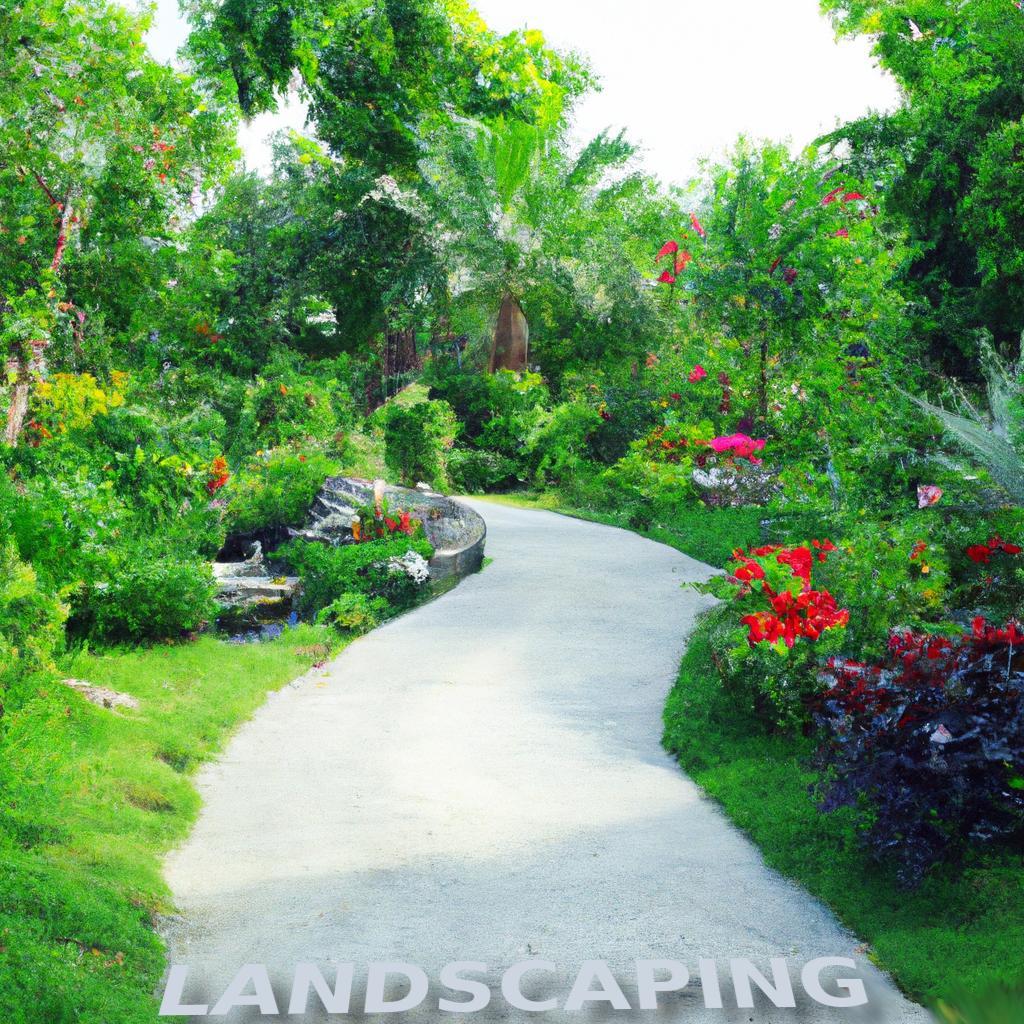


In the canvas of outdoor spaces, the synergy between landscaping and trees is a harmonious masterpiece—where nature's palette meets human creativity. From quaint gardens to sprawling parks, the art of landscaping and the majestic presence of trees collaborate to transform environments into living works of art. Let's embark on a journey through the verdant landscapes, where design meets ecology, and the alliance of landscaping and trees becomes the poetry of outdoor aesthetics.
Green Tapestry: Landscaping as an Artistic Expression
Landscaping is the art of sculpting nature, a practice that transforms outdoor spaces into living galleries. Landscape architects wield a palette of plants, stones, water features, and architectural elements to craft environments that resonate with both aesthetics and functionality. From manicured lawns to wildflower meadows, landscaping is the artful arrangement of natural elements, creating spaces that evoke emotions and tell stories.
Trees as Sentinels: The Majestic Guardians of Outdoor Spaces
Within the realm of landscaping, trees stand as sentinel guardians—towering symbols of strength, longevity, and ecological balance. Beyond their aesthetic appeal, trees provide shade, enhance air quality, and contribute to the overall well-being of ecosystems. The selection of tree species becomes a critical decision in landscaping, as each variety brings unique characteristics, from vibrant foliage to seasonal blooms.
The Symphony of Seasons: Trees as Living Art Installations
Landscaping with trees introduces a dynamic element—the ever-changing canvas of seasons. Cherry blossoms herald spring's arrival with a burst of pink, while the fiery hues of autumn leaves paint a mesmerizing picture. Landscape architects strategically choose tree species that offer a kaleidoscope of colors throughout the year, ensuring that outdoor spaces are not static but dynamic, evolving galleries of living art.
Arboreal Architecture: Trees Shaping Outdoor Spaces
Trees are not mere bystanders; they are architects in their own right, shaping outdoor spaces with their canopy, branches, and roots. Canopy trees provide shade and define the character of a space, while ornamental trees add texture and diversity. Strategic placement of trees creates natural boundaries, frames vistas, and guides the flow of outdoor areas, turning them into curated environments that invite exploration.
The Ecological Ballet: Landscaping for Biodiversity
Landscaping goes beyond aesthetics; it's a choreography for biodiversity. Trees play a crucial role in this ecological ballet, providing habitats for birds, insects, and other wildlife. Native tree species, carefully integrated into landscaping plans, contribute to the preservation of local ecosystems. The result is not just a visually appealing landscape but a thriving ecosystem where nature's interconnected web flourishes.
Tranquil Retreats: Landscaping as a Sanctuary of Serenity
In the hustle and bustle of urban life, landscaping becomes a sanctuary of serenity. Trees, strategically placed to create secluded corners, provide havens for relaxation and contemplation. Courtyard gardens with lush greenery and shaded alcoves offer a retreat from the cacophony of daily life, inviting individuals to reconnect with nature and find solace in outdoor sanctuaries.
Sustainable Landscaping: Nurturing Nature in Harmony
The principles of sustainability guide modern landscaping practices, emphasizing water conservation, soil health, and energy efficiency. Native trees, adapted to local climates, require less maintenance and irrigation. Rain gardens and permeable surfaces contribute to water conservation, while energy-efficient lighting ensures that outdoor spaces are not just beautiful but also environmentally responsible.
Timeless Allure: Landscaping and Trees as Legacy
Landscaping and trees create outdoor spaces that transcend generations. Trees, with their slow growth and enduring presence, become living monuments that witness the passage of time. Landscaping designs, carefully curated and maintained, leave a lasting imprint on the cultural and environmental legacy of a place, ensuring that the allure of outdoor spaces stands the test of time.
Landscaping innovations have come a long way in recent years, with new technologies and designs emerging that offer a range of benefits to humans. Some of these innovations include:
Sustainable Landscaping: This involves using environmentally friendly practices, such as reducing water usage and eliminating chemical pesticides, to create beautiful landscapes that are healthy for both people and the planet.
Vertical Gardens: These are gardens that are designed to grow vertically, usually on walls or other vertical surfaces. They are great for small spaces, and can also provide a range of benefits such as reducing air pollution, improving indoor air quality, and reducing energy consumption.
Smart Irrigation Systems: These systems use sensors and weather data to adjust watering schedules, ensuring that landscapes receive the right amount of water at the right time. This can help to conserve water and save money on utility bills.
Living Roofs: Living roofs are roofs that are covered in plants, which provide insulation, reduce stormwater runoff, and improve air quality. They are becoming increasingly popular in urban areas, where they can help to mitigate the "heat island" effect and provide green space in otherwise concrete-dominated landscapes.
Outdoor Lighting Innovations: New outdoor lighting systems are being developed that are energy efficient and more controllable than traditional lighting. These can help to reduce light pollution, save energy, and create beautiful nighttime landscapes.
These landscaping innovations are helping to create healthier, more sustainable, and more beautiful outdoor spaces for humans. They are also contributing to a more sustainable future, by reducing the impact of landscaping practices on the environment.
Landscaping work and services typically involve the design, installation, and maintenance of outdoor spaces to enhance their functionality, aesthetics, and environmental sustainability.
Here are some common types of landscaping work and services:
Landscape Design: This involves creating a comprehensive plan for the landscaping project, including site analysis, plant selection, hardscape design, and drainage planning.
Planting: Planting services typically involve selecting and installing plants, shrubs, and trees to enhance the visual appeal and functionality of outdoor spaces.
Hardscaping: Hardscaping refers to the use of non-living elements in outdoor spaces, such as walkways, patios, retaining walls, and outdoor kitchens. Hardscaping can improve the functionality of outdoor spaces and create distinct areas for different activities.
Irrigation: Irrigation services involve designing and installing watering systems to ensure that plants and lawns receive adequate water for growth and health.
Maintenance: Regular maintenance is essential for the health and longevity of outdoor spaces. Maintenance services may include mowing, pruning, fertilizing, and pest control.
Lighting: Outdoor lighting can enhance the functionality and aesthetics of outdoor spaces, as well as improve safety and security. Lighting services may include the design, installation, and maintenance of outdoor lighting systems.
Tree services involve a range of tasks aimed at ensuring the health, safety, and aesthetic appeal of trees. Here are some common types of tree services:
Tree Pruning: This involves selectively removing branches from trees to improve their health, structure, and appearance. Pruning can also reduce the risk of falling branches and promote healthy growth.
Tree Removal: Tree removal may be necessary when trees are dead, diseased, or pose a safety hazard. Tree removal involves cutting down the tree and removing the stump and debris.
Tree Trimming: Tree trimming involves removing small branches to shape the tree and enhance its appearance. This can also help improve the tree's health and prevent it from becoming overgrown.
Tree Planting: Tree planting services involve selecting and planting trees in appropriate locations to improve the aesthetic appeal and environmental sustainability of outdoor spaces.
Stump Grinding: Stump grinding involves removing the stump of a tree after it has been cut down. This can improve the appearance of outdoor spaces and prevent the stump from causing tripping hazards.
Tree Health and Disease Management: Tree service providers may also offer services aimed at maintaining and improving the health of trees, such as fertilization, pest control, and disease management.
Cutting trees and bushes can be a challenging task that requires skill, knowledge, and proper equipment. Here are some tips to help make the process safer and more effective:
Safety First: Always wear protective gear such as safety glasses, gloves, and sturdy footwear to protect yourself from injury. Additionally, make sure that the area is clear of people and obstacles before starting work.
Plan Ahead: Before starting work, plan your cuts carefully to ensure that the tree or bush falls in the desired direction. Identify any potential obstacles, such as power lines or buildings, and make sure that they are clear of falling trees or bushes.
Choose the Right Tools: Use the appropriate tools for the job, such as pruning shears, loppers, or a chainsaw, depending on the size of the tree or bush. Make sure that your tools are sharp and in good condition to ensure a clean cut.
Cut Carefully: When making cuts, use steady, even pressure, and avoid sawing back and forth, which can damage the tree or bush. For larger branches, use the three-cut method, making an undercut, a top cut, and a final cut to prevent the branch from falling and causing damage.
Dispose of Debris Properly: Once the tree or bush is cut down, dispose of the debris properly. Consider using the wood for firewood or mulch, or hire a professional tree service to remove the debris.
Hire a Professional: If you are not experienced with tree or bush cutting, or if the job is too large or dangerous to handle on your own, consider hiring a professional tree service to do the work for you. Professional tree services have the experience, knowledge, and equipment necessary to safely and effectively cut trees and bushes.
Landscaping can be a great way to enhance the beauty and functionality of your outdoor space. Here are some tips to help make the process more successful:
Plan Ahead: Before starting any landscaping work, take the time to plan your project carefully. Consider factors such as the size and shape of your outdoor space, the style of your home, and your budget. Create a detailed plan and make sure that you have all of the necessary materials and tools on hand.
Choose the Right Plants: When selecting plants for your landscaping, choose species that are well-suited to your climate and soil type. Consider factors such as the amount of sunlight and water your plants will receive, as well as their mature size and growth rate.
Use Layers: Layering your plants and other landscaping elements can help create depth and texture in your outdoor space. Consider using tall plants and trees to provide height, mid-sized plants for visual interest, and groundcover plants to fill in gaps and provide texture.
Add Hardscaping: Hardscaping elements such as patios, pathways, and retaining walls can help define your outdoor space and create visual interest. Choose materials that complement your home's style and color scheme.
Consider Lighting: Outdoor lighting can enhance the beauty and functionality of your outdoor space by illuminating key features and creating ambiance. Consider using a combination of overhead and accent lighting for the best effect.
Maintain Your Landscaping: Regular maintenance is essential for keeping your landscaping looking its best. This may include tasks such as mowing the lawn, trimming plants, and watering as needed. Consider hiring a professional landscaping service to help with ongoing maintenance tasks.
The partnership between landscaping and trees is a captivating dance that transforms outdoor spaces into living artworks. From the curated designs of landscape architects to the enduring majesty of trees, this alliance creates environments that inspire, rejuvenate, and connect individuals with the beauty of the natural world. In the embrace of landscaping and the shade of majestic trees, outdoor spaces become not just places but experiences—invitations to immerse oneself in the artistry of nature.
Transform your property into an oasis with professional landscaping services. Create a beautiful outdoor space that you can be proud of with the right landscaping design. Enjoy the benefits of a beautiful and well-maintained landscape, including improved curb appeal, property value, and quality of life!
Sincerely yours,

We use cookies
We use cookies and other tracking technologies to improve your browsing experience on our website, to show you personalized content and targeted ads, to analyze our website traffic, and to understand where our visitors are coming from. Privacy Policy.